Q&A with Professor Elizabeth McCauley on adolescent mental health
A staged image demonstrates the mental struggles teenagers have experienced during social isolation. Dr. Elizabeth McCauley addresses how teenagers can cope with mental health issues during the COVID-19 quarantine.
May 21, 2020
The Southerner’s Kamryn Harty speaks with University of Washington’s Professor Elizabeth McCauley on the status of adolescent mental health in quarantine. Dr. McCauley is Professor in the Department of Psychiatry and Behavioral Sciences at the University of Washington, and Director of the Mood and Anxiety Program at Seattle Children’s Hospital. Disclaimer: Interview has been edited for clarity and length.
What are some of the overlying impacts of social isolation on teenagers’ mental health? (Short and Long term)
The imposed social isolation we are experiencing in response to COVID-19 is of course not like anything we have experienced before—so we don’t know much about how it will affect adolescent mental health. There are however, a growing number of anecdotal reports that suggest possible short-term consequences—none can speak with authority about long-term consequences.
Key points:
Research on adolescent development (before COVID19) suggests that the development of social relationships and skills in managing social relations is a critical part of adolescence development. The shift of focus from parents/family to peers characterizes adolescence. This does not necessarily mean conflict with parents but more the growth of stronger attachments to peers and dependence on peers for validation of self. Studies suggest that youth who miss typical adolescent socialization opportunities (due to illness, repeated moves, etc.) may have limited opportunities to learn the social skills used in navigating the peer environment and find these skills harder to pick up as they move into adulthood.
We are seeing reports now of adolescents who report increased stress because of limited contact with friends and feeling “stuck” at home with family. This sense of social isolation can increase feelings of loneliness, anxiety, depression and anger. Feeling “left out”, not knowing what is going on, fearing that others are more connected; all contribute to the intensification of feelings of anxiety and depression. See below for some strategies to overcome.
There are also reports of some positive developments. Mental health providers who are now providing care via an internet platform report, again anecdotally only, that adolescents respond well to getting care online. Most adolescents are comfortable with video connections and conversations. Mental Health workers also report that it is great to be able to have their adolescent clients introduce them to their home space, their pets, and their favorite possessions. Other positive outcomes are reflected in the creative responses many adolescents have developed to connect with friends—parties on zoom, remote graduations, drive by/parade birthday celebrations.
Is it common to be struggling with a lack of focus/motivation during quarantine?
Absolutely –there is a lot of advice circling about the difficulties that everyone is having with focus and motivation to get routine things done. Some ideas about how to deal with this include:
- Giving yourself some ‘grace’ right now—that it is okay that you are not accomplishing as much as usual and that most people are feeling less motivated right now. For adolescents, this might need to be a conversation with parents/family about setting realistic/reasonable expectations for now. There are many articles out in the popular press about allowing yourself to have more down time, e.g. time to lose yourself in binge watching a series, however this is harder for adolescents whose parents might be pressuring them to keep up with homework or home chores. Again, setting some sort of schedule that includes some time to try to focus on school work or music practice coupled with ample time to engage in more relaxing, distracting activities will be important—clearly adolescents and parents need to work together on this so the parent sees the active steps the adolescent is taking, not just the down time behaviors.
- Take some time to break down big tasks—say a big school assignment into small ‘doable steps,’ give yourself a break, or at least a pat on the back after each step is completed, set up an incentive for yourself so that you will take the steps outlined—e.g. connect with friend after step is completed—not before
How can teenagers coping with anxiety deal with pressure to increase productivity during this time?
Here are some tips from my colleagues Kendra Read, PHD and Jen Blossom, PHD—both work with our anxiety programs.
- A key piece may be rethinking the definition of “productive” during this time. Productivity apps (e.g., using a Pomodoro app) may be helpful to foster effective productivity – this could help shift the goal/measure of success. For example, “my goal is to work for 25 minutes.” Rather than, “I need to complete this homework assignment” (effort rather than outcome).
It is important recognize how thoughts influence our feelings (and then our behaviors), while also recognizing that our thoughts are just thoughts: they are not necessarily true or helpful. This is a perfect opportunity to practice cognitive restructuring skills – identifying anxious thoughts, thinking traps, and generating more helpful or rational thoughts. Around this specific situation, I might ask myself/oneself: Is it true that I need to be more productive? What might also be true? Check the facts around the evidence received around this thought. Ex: If teachers are assigning work- is all of this required? Extra?
Practice doing things that have no benchmark for achievement as an exposure AND self-care. [Some examples include:] Cuddling your dog, reading for fun (this can get tricky with anxious/OCD kids), going for a walk around the neighborhood, Face timing a friend, taking a bath, sitting outside to eat lunch
Engage in other exposures to challenge anxious expectations
a. Ideas:
Do things out of order, make mistakes, be less productive, or turn in work late
b. [Reflect]: What really happens when you do this? Is it as bad as you expected?
What are some tips for teenagers struggling with eating disorders/body image issues in isolation?
These great ideas come from my colleague Nicole Stettler, PHD who works with me here at Seattle Children’s and works with many youth with eating/body image issues.
- Have a regular schedule of eating (no more than 3-4 hours between meals/snacks). This goes along with building in daily routines overall, which is good advice for anyone right now and can help with mood as well.
- Identify distractions or other distress tolerance activities to do after eating, if that is a time when negative feelings and urges arise.
- Identify people you can rely on for support, whether that’s parents providing support during meals, friends who can provide distracting conversations between meals, or professionals you can reach out to for ideas.
- Have a routine of physical activity that you enjoy. Amount/frequency/intensity of physical activity should not be determined by how much you’ve eaten.
- Notice and disrupt body-checking behaviors. Limit your access to scale, measuring tapes, etc.
- Notice and disrupt comparing yourself to others. You could limit social media use each day. You could also do a virtual version of the CBT body comparison exercise by comparing yourself to every 3rd person you see of your age and gender (but not that social media algorithms may make it difficult to get an unbiased sample).
Self-help books I would recommend would be Cash’s Body Image Workbook, Fairburn’s Overcoming Binge Eating (appropriate even for people who don’t binge eat, as ED behaviors put everyone at risk for objective/subjective binges), and No Weigh! By Darpinian, Sterling, and Aggarwal.
How much screen time is too much screen time? What are some alternate activities that you recommend teens can do to pass the time?
The debate on how much screen time is too much screen time is ongoing. Much attention, and criticism, has been focused on a series of papers published in 2017-19 (Twenge, et al., 2017, 2019), which suggested that greater use of social media/time on the internet was associated with self-reports of greater depression and suicidal behaviors in a large cross sectional sample of adolescents. In these studies they report that adolescents using devices 5+ hrs./day were 66% more likely than youth using 1hr a day, to have at least one suicide related outcome. A recent, comprehensive review (Odgers & Jensen, 2020), which included multiple sources of data including narrative reviews and meta-analyses conducted between 2014 and 2019, large-scale preregistered cohort studies, and intensive longitudinal and ecological momentary assessment studies found, however, a small association between daily digital technology usage and adolescents’ well-being … “unlikely to be of clinical or practical significance.”
During this time of quarantine, however, all of us, including adolescents are going to be on “screens” much, much more. Screens are now their only way to continue with school, connect with friends and family, as well as serving as a major source of entertainment and distraction—films, games, videos, on and on. Adolescents feel, justifiably, that they are losing a lot right now—school, parties, sports, concerts, proms, graduations….on and on. Central to much of this is their loss of connection to their peers, which is an essential connection. Even if others are “stuck” at home, they fear being left out of conversations, online events, and this leads to increased sense of both loneliness and anxiety. So most experts are suggesting that for now normal rules and restrictions are not useful.
That said, it is still important to guide youth to a variety of activities they can engage in on and OFF the internet—including getting outside if possible, exercise, keeping regular sleep patterns, socializing with family, which might mean setting up structured activities to keep things positive—games, puzzles, cooking, crafts, etc. These activities can of course be done solo as well.
As noted above it is critical to:
- Have a regular schedule
- Avoid staying up into the night and sleeping in the day—it is important to get exposure to daylight for our sleep and mental health
- Schedule in both screen and non-screen activities—and try to stick with the plan
- Avoid multitasking—trying to keep us with social media while also trying to do school work, read, sleep, exercise.
- If possible build in physical activities—even the NYT 6 minute workout, or encouragement to walk around your own home—even 4000 steps helps physical and mental health.
- Use screen time planfully—
-
- Set up times to be online with friends to work together on schoolwork, watch a movie, have a “party”, play a game, do an exercise routine, play music together.
- Use screen time to try to learn a new skill—a recipe, a crafts project, juggling, a new song to work on and then apply off line
-
How can those that are struggling with mental health get help in quarantine? What are some resources teenagers can easily reach for support?
Here are some national ones but you will need to id resources in your local community.
- National Suicide Prevention Lifeline, 800-273-8255
- If you or a family member has a problem with a substance use disorder, please consider calling SAMHSA’s National Helpline, 800-662-4357.







